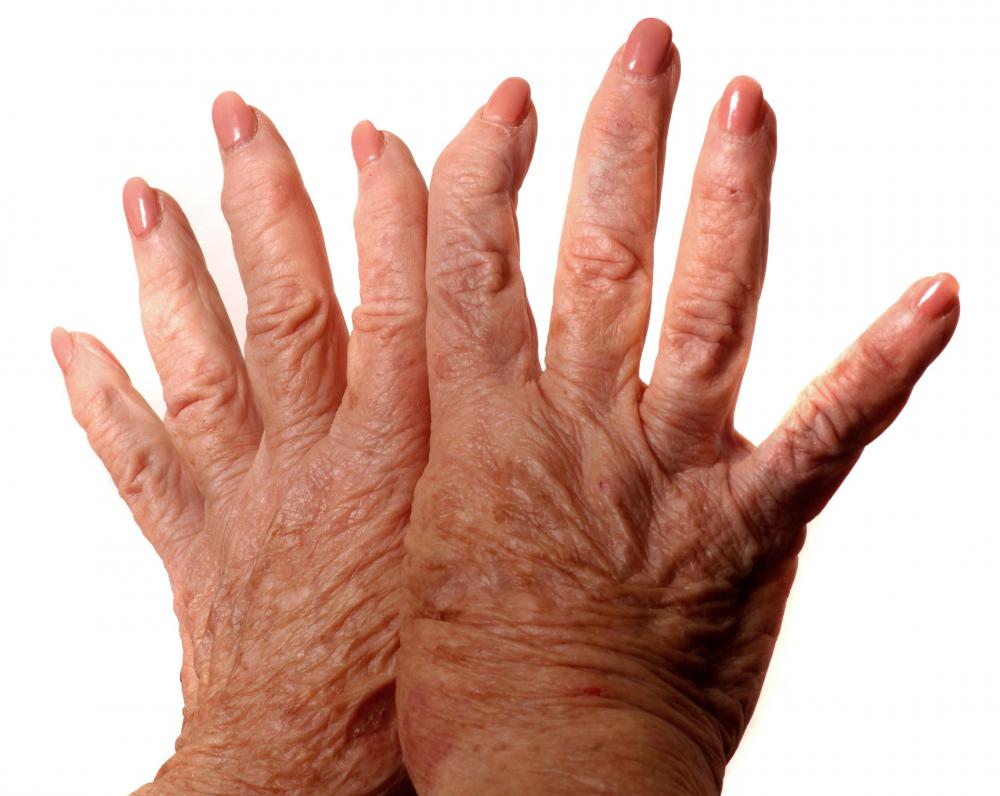At TheHealthBoard, we're committed to delivering accurate, trustworthy information. Our expert-authored content is rigorously fact-checked and sourced from credible authorities. Discover how we uphold the highest standards in providing you with reliable knowledge.
What is the Difference Between Lupus and Scleroderma?
Lupus and scleroderma are in the same family of connective tissue diseases, but they are distinct disorders that are different in appearance, have different symptoms and have different treatments. Both conditions are autoimmune disorders, resulting from an overactive immune system that attacks the body's own tissues as foreign substances. Whereas lupus is primarily an inflammatory disease, scleroderma is a fibrous disease affecting the connective tissues.
The differences between lupus and scleroderma begin with the characteristic appearance of each condition. Lupus is characterized by a distinctive "butterfly" rash on the face; that is, a red rash that spreads across the cheeks and the bridge of the nose. Scleroderma, however, is defined by thickened and hardened skin, usually on the fingers but also on the hands, feet, forearms and face.

The exact causes of each condition are unknown, but there might be a genetic component. Scleroderma results from an overproduction of collagen, a connective tissue present throughout the body and a component of scar tissue. Lupus is an inflammatory disease that affects the skin, joints, kidneys, heart, lungs and blood cells.
As autoimmune disorders, lupus and scleroderma have similarities. Both disorders affect multiple organs, most commonly blood vessels, and both occur more often in women than men. They are considered "overlap" diseases because they are closely related and share symptoms, such as an exaggerated response to cold. The diseases might occur together in the same person, although this is not common. Approximately 4 percent of people with lupus also have scleroderma.

Symptoms of lupus vary greatly from person to person, and they can depend on the severity of the condition. In addition to the butterfly rash, other typical symptoms include fatigue, fever, weight change and pain or stiffness on the joints. They also might include hair loss, skin rashes that appear or worsen after sun exposure and mouth sores. People who have lupus might also find that their fingers or toes turn numb and discolored when cold.

The classic symptom of scleroderma is fingers or toes that turn white or gray when exposed to cold. Other symptoms include thickened patches of skin on the fingers or hands and tight skin on the face or hands. Heartburn and gastroesophageal reflux disease also are common symptoms.
Diagnosis of lupus and scleroderma is difficult. There is an overlap between these conditions and other autoimmune disorders, such as Sjogren's syndrome and rheumtoid arthritis, so the diagnostic process can be lengthy. Diagnosis is based on examinations by rheumatologists and the results of blood tests.

Lupus and scleroderma have no cure, but the symptoms can be treated. Lupus usually is treated with nonsteroidal anti-inflammatory drugs such as ibuprofen or acetaminophen as well as corticosteroids to control inflammation. Antimalarial drugs also are effective, although there is no known connection between lupus and malaria. Lupus typically cycles between periods of flares and dormancy.
Symptoms of scleroderma are treated with heartburn medications and agents to suppress the immune system. Blood pressure medications also might be used. These medications dilate the blood vessels to improve circulation.
AS FEATURED ON:
AS FEATURED ON:


















Discussion Comments
I have them both, plus much more. Some symptoms are confusing since there is overlap.
Though with scleroderma I have hardened skin in between my toes, like an extra layer you can scratch off, since it is dry/crusty like. Yuck, but all white and extra dry, not yellow.
With scleroderma flares, lips or face can also blister. Mine went from fine to red, to full out blisters in just a few hours, and took a few weeks to fully heal. It's kind of like a fever blister (x 10).
I also have shiny skin with scleroderma. If I hold the palms of my hands up to the sunlight and tilt them back and forth slightly, I can see what looks like glitter. It is the extra deposits in the skin.
Good luck getting diagnosed. I have had lots of autoimmune problems for many years, with nothing flagging until a few years ago, but even then it wasn't enough to get officially diagnosed with certain disorders (they knew I had something since a few things flagged, but wouldn't diagnose me yet). They knew I already had the gluten intolerance diagnosed through a stool sample since I never flagged on the blood test multiple times (which apparently meant I was fine. Ha. Probably why I stopped wasting my money on blood tests.
I had heard that if I went undiagnosed with gluten intolerance (not caught in childhood), by the time I was diagnosed (due to figuring it out myself and buying a stool test and sending it in to a specialized lab), that multiple autoimmune disorders were possible, since the body is way past the stage of angry. Fortunately, I kept an open mind on how to deal with my health. I read everything that everyone said about it on the internet. (doctor comments, studies. and most important, those who suffered from it, and the took an out-of-the-box chance. Had I not done so, I would have been dead a long time ago. I don't have the best of health. but am still kicking past my expiration date. Good luck on your journey.
Post your comments